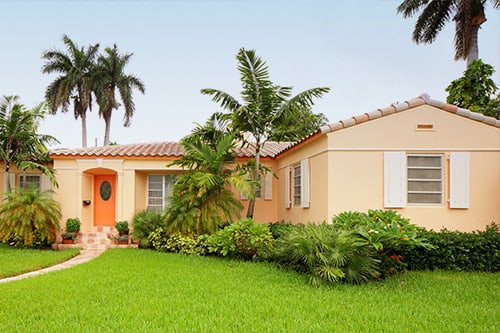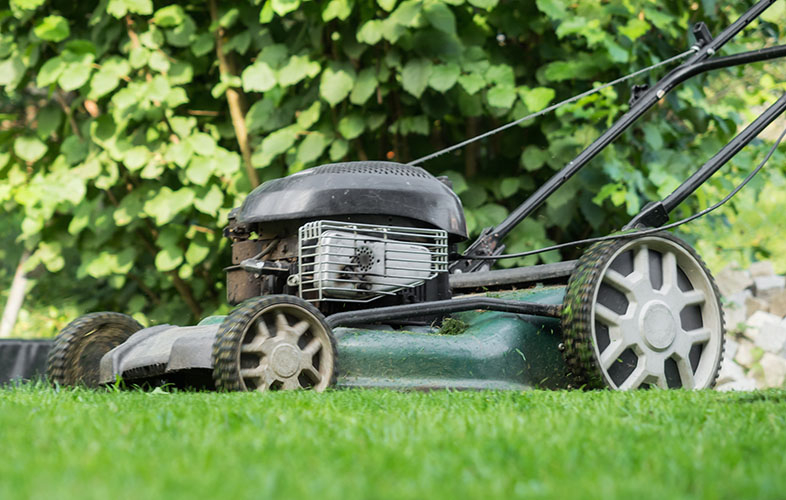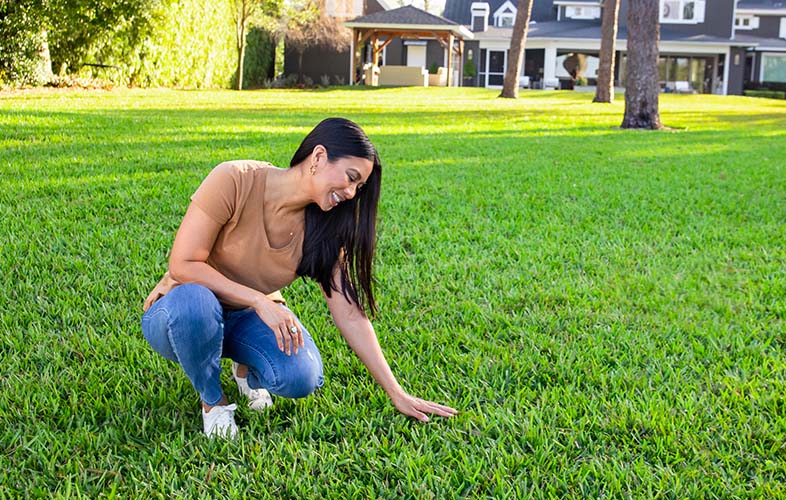Our comprehensive Florida lawn guide covers Florida grass types, insect control, turf disease fungus. Check it out for a complete guide to getting a great lawn in Florida.

A healthy Florida lawn isn't just good for your family, it can also be an asset to the urban environment for Florida as a whole. Well-tended lawns in Florida can cool and clean the air, reduce glare and noise, and filter pollutants out of groundwater. Plus, a lush, green lawn is quite nice to look at.
Environmental Stress to Florida Grass and Lawns
According to the University of Florida IFAS extension, Florida lawns and turf grasses are subject to many environmental stresses including nutrient deficiency, salinity, temperature extremes, over- or underwatering, soil problems, and prolonged exposure to shade or traffic. That doesn't even cover the Florida specific insects and lawn diseases that can present themselves. But worry not. TruGreen is a partner in your quest for a healthy, lush lawn. Below are tips and details for what to expect from your Florida lawn each season, including some of the nuisances that you may encounter, with links to programs we offer to prevent or fix the lawn problems pertaining specifically to Florida residents.
Common Types of Florida grass
Common grasses found in Florida lawns include Centipede, Zoysia, Bahiagrass, Bermudagrass, and St. Augustine; each comes with its own set of pros and cons. By identifying or selecting the right grass for your yard, you can determine how to best care for your grass in Florida
Bahia
Pros
- Coarse-textured, tough turf
- Good tolerance to shade, drought, and wear
Cons
- Produces numerous seedheads
Bermuda
Pros
- Dense, medium-fine texture
- Excellent heat and drought tolerance
- Rapid establishment and growth rate
Cons
- Poor low temperature and shade tolerance
- Becomes dormant and browns during winter months
Centipede
Pros
- Low-growing, medium textured turf
- Can handle light shade
- Drought-tolerant
Cons
- Slow growing (but this could be a pro if you don’t like mowing often!)
- Poor wear tolerance
- Browns in winter
- Requires high iron levels
St. Augustine
Pros
- Coarse-textured turf
- Shade-tolerant
Cons
- Poor low-temperature tolerance
- Can enter dormancy and discolor in winter months
- Produces heavy thatch
Zoysia
Pros
- Dense, tough turf
- Good heat and drought tolerance
- Better cold tolerance than most warm-season grasses
Cons
- Slow to establish
- Becomes dormant and browns during winter months
Types of weeds in Florida & South Florida
Unfortunately, good lawn care requires preventative and reactionary efforts. The types of weeds listed below should be kept in mind as you work with your local TruGreen specialist to make your lawn the best it can be.
Crabgrass
In Florida, Crabgrass acts as a perennial warm-season weed, which means it thrives in the heat and will sprawl anywhere it can find sunlight, water, and bare soil. Without proper prevention techniques and regular maintenance, a crabgrass invasion can quickly spiral out of control.
Dollarweed
Also called pennywort, dollarweed is a warm-season perennial weed named for its silver- dollar-shaped leaves. The leaves of dollarweed are round, green, and look like little lily pads with a scalloped edge.
Perennial kyllinga
Weeds in the kyllinga family tend to have a finer leaf texture and thrive in lawns mowed short (one inch or less). They are abundant in areas with poorly drained or frequently wet yards.
Doveweed
This summer weed germinates late in the spring and is often confused with St. Augustine grass and centipede grass leaves due to its shiny, rubbery texture. Doveweed prefers wet areas, so avoid drainage issues and overwatering even though it may seem rational with Florida’s hot climate.
Spurge
The spurge family includes fast-growing summer weeds that grow low to the ground. Spurge is known as a prolific seed producer, and plants mature in just a few days during the scorching hot Florida weather.
Chamberbitter
Also known as gripeweed, Chamberbitter is a warm-season, broadleaf weed that can be spotted growing in early summer in Florida. This weed will grow upright and has a well-developed taproot.
For fighting common weeds in Florida lawns and yards, consider TruGreen's TruComplete Lawn Plan, which includes pre-emergent and targeted weed control to ensure a lush Florida lawn for you and your family.
Types of Lawn Disease and Pests in Florida and South Florida
Common Florida lawn diseases include brown patch and gray leaf spot, though the latter only affects St. Augustine grasses.
For fighting common lawn diseases in Florida, consider lawn care service customized plans through TruGreen such as our TruHealth Lawn Plan, which provides protection, essential nutrients, and balanced soil to your Florida lawn.
Common Florida lawn pests include chinch bugs, mole crickets, sod webworms, armyworms, and fire ants.
Florida Lawn Care Pest Control Advice from TruGreen Local Experts
For fighting common lawn pests in Florida, consider TruGreen’s TruShield Lawn Pest Control, which can significantly reduce the number of pests in your yard, or Mosquito Defense, which can help control biting mosquitoes on your property.
Seasonal Florida Lawn Care Schedule, Tips, & Expert Advice
Your lawn's needs change month-to-month and season-to-season. While your Florida local lawn care TruGreen specialist will help your yard stay healthy, there are still components of lawn care that you as the homeowner will need to watch and care for. The tips below will help you stay on track for a lush, healthy yard you’ll love and be proud of:
Summer Lawn Care in Florida
- Water your lawn at the first signs of drought stress, and continue watering through the season. Signs of drought stress include thin, brown, and folding grass.
- Aerating in early June may help with summer stress. Ask your specialist about TruGreen's aeration services.
- Aim to give your lawn about 1 inch of water per week but be sure to follow local water restrictions, if in place.
- As temperatures continue to increase, allow your lawn's soil to become wet several inches.
- If your lawn begins to develop bare spots, ask your TruGreen specialist for lawn plug options.
Fall Lawn Care in Florida
- As the weather begins to cool, cut back on watering frequency.
- Mow less often and don't lower the mower's height.
- Shred fallen leaves into the grass to provide organic matter.
- If you use an irrigation system, reprogram it to reflect winter watering needs.
Spring Lawn Care in Florida
- Continue to mow and water as necessary. As weather temperatures begin to increase, waterings may need to increase as well.
- Check for signs of crabgrass and talk to your specialist if the weed begins to develop. Learn how to spot crabgrass by watching the video above.
- If your lawn begins to develop bare spots, ask your TruGreen specialist for lawn plug options.
- As spring continues, ensure proper mowing, removing no more than ⅓ of the leaf blade.
- Leave any clippings on the lawn, unless you're experiencing a disease problem.
- Rake or dethatch coarse lawns in the late spring season for optimal Florida lawn maintenance. Allowing thatch to develop can cause disease and weaken grasses.
- Before summer hits, take preventative Florida lawn care services to control chinch bug activity (which increases in June). TruGreen's TruHealth and TruComplete plans can both help with chinch bug control during these tough Summer months in Florida.
TruGreen Florida Residential Lawn Care Services
Together, we can make great-looking Florida turf grass year-round!
Florida's unique grasses and weather climate mean your lawn or backyard needs special care and attention from a local expert. We can team up to apply seasonally appropriate pre- and post-emergent weed treatments, as well as fertilizer, to stimulate your lawn's color and growth and to help fortify it against extreme weather. To achieve a healthy lawn, we ask that you receive regular service visits with TruGreen lawn care & maintenance experts, and follow the guidelines outlined above to help you achieve the best results possible. If you're not signed up yet for regular services, click here to find a local branch near you or fill out the green box to get a personal quote today.













